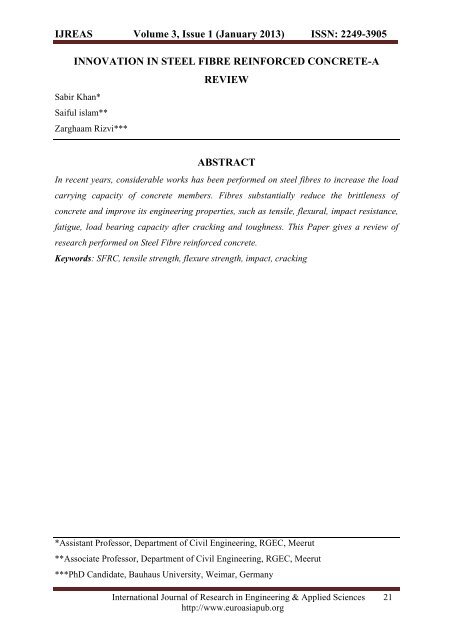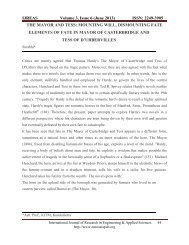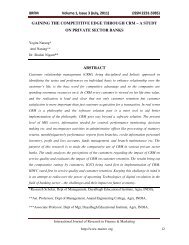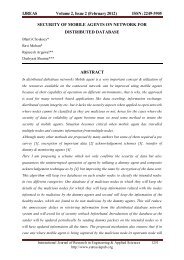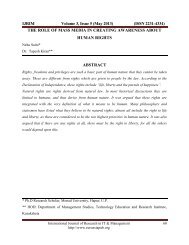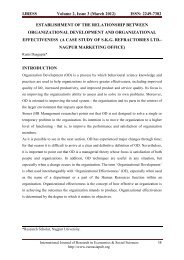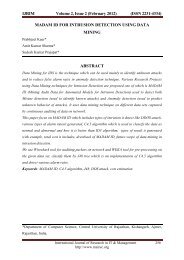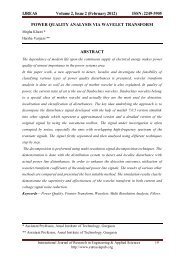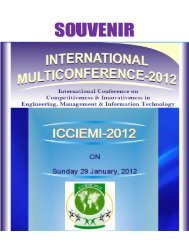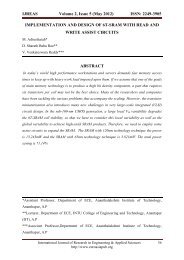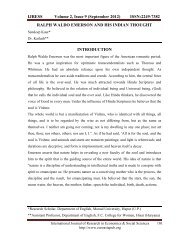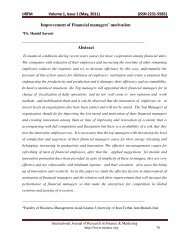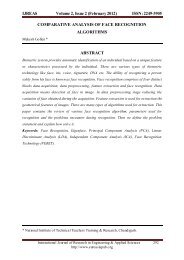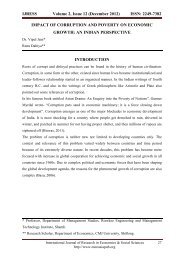innovation in steel fibre reinforced concrete-a ... - Euroasiapub.org
innovation in steel fibre reinforced concrete-a ... - Euroasiapub.org
innovation in steel fibre reinforced concrete-a ... - Euroasiapub.org
- No tags were found...
You also want an ePaper? Increase the reach of your titles
YUMPU automatically turns print PDFs into web optimized ePapers that Google loves.
IJREAS Volume 3, Issue 1 (January 2013) ISSN: 2249-3905INNOVATION IN STEEL FIBRE REINFORCED CONCRETE-AREVIEWSabir Khan*Saiful islam**Zarghaam Rizvi***ABSTRACTIn recent years, considerable works has been performed on <strong>steel</strong> <strong>fibre</strong>s to <strong>in</strong>crease the loadcarry<strong>in</strong>g capacity of <strong>concrete</strong> members. Fibres substantially reduce the brittleness of<strong>concrete</strong> and improve its eng<strong>in</strong>eer<strong>in</strong>g properties, such as tensile, flexural, impact resistance,fatigue, load bear<strong>in</strong>g capacity after crack<strong>in</strong>g and toughness. This Paper gives a review ofresearch performed on Steel Fibre re<strong>in</strong>forced <strong>concrete</strong>.Keywords: SFRC, tensile strength, flexure strength, impact, crack<strong>in</strong>g*Assistant Professor, Department of Civil Eng<strong>in</strong>eer<strong>in</strong>g, RGEC, Meerut**Associate Professor, Department of Civil Eng<strong>in</strong>eer<strong>in</strong>g, RGEC, Meerut***PhD Candidate, Bauhaus University, Weimar, GermanyInternational Journal of Research <strong>in</strong> Eng<strong>in</strong>eer<strong>in</strong>g & Applied Sciences 21http://www.euroasiapub.<strong>org</strong>
IJREAS Volume 3, Issue 1 (January 2013) ISSN: 2249-39051. INTRODUCTIONConcrete is one of the most widely used construction materials. It is used <strong>in</strong> a variety ofapplications such as highways, high-rise build<strong>in</strong>gs, dams, bridges, sidewalks, and residentialconstruction. Concrete was used as long ago as the Greek and Roman civilizations . Concreteis used as a good construction material due to its property of high compressive strength.However, s<strong>in</strong>ce the early 1800’s, it has been known that <strong>concrete</strong> is very weak <strong>in</strong> tension.This comes from the brittle nature of the material. Weak tensile strength comb<strong>in</strong>ed withbrittle behavior results <strong>in</strong> sudden tensile failure without warn<strong>in</strong>g. This is obviously notdesirable for any construction material. Thus, <strong>concrete</strong> requires some form of tensilere<strong>in</strong>forcement to make up for its brittleness and improve its tensile strength and stra<strong>in</strong>capacity for it to be used <strong>in</strong> structural applications. Steel has been used as the material fortensile re<strong>in</strong>forcement <strong>in</strong> <strong>concrete</strong>. For <strong>steel</strong> re<strong>in</strong>forcement to be effective, it has to be placedstrategically <strong>in</strong>side <strong>concrete</strong> where tensile stresses are expected. Unlike conventionalre<strong>in</strong>forc<strong>in</strong>g bars, which are specifically designed and placed <strong>in</strong> the tensile zone of the<strong>concrete</strong> member, fibers are th<strong>in</strong>, short and distributed randomly throughout the <strong>concrete</strong>member. The random distribution results <strong>in</strong> a loss of efficiency as compared to conventionalre<strong>in</strong>forced bars, but the closely spaced fibers improve toughness and tensile properties of<strong>concrete</strong> and help to control crack<strong>in</strong>g. In many situations it is prudent to comb<strong>in</strong>e fiberre<strong>in</strong>forcement with conventional <strong>steel</strong> re<strong>in</strong>forcement to improve performance (Derucher,1998. Although re<strong>in</strong>forc<strong>in</strong>g brittle materials with fibers is an old concept, modern day use offibers <strong>in</strong> <strong>concrete</strong> is only started <strong>in</strong> the early 1960s. Realiz<strong>in</strong>g the improved properties of thefiber re<strong>in</strong>forced products, research and development work on fiber re<strong>in</strong>forced <strong>concrete</strong> (FRC)are <strong>in</strong>itiated about three decades ago. This paper provides a review of works performed onfiber re<strong>in</strong>forced <strong>concrete</strong>.2 EXPERIMENTAL RESEARCHRomualdi and Batson (1963) after conduct<strong>in</strong>g impact test on <strong>fibre</strong> re<strong>in</strong>forced <strong>concrete</strong>specimens, they concluded that first crack strength improved by addition of closely spacedcont<strong>in</strong>uous <strong>steel</strong> <strong>fibre</strong>s <strong>in</strong> it. The <strong>steel</strong> <strong>fibre</strong>s prevent the advert<strong>in</strong>g of micro cracks byapply<strong>in</strong>g p<strong>in</strong>ch<strong>in</strong>g forces at the crack tips and thus delay<strong>in</strong>g the propagation of the cracks.Further, they established that the <strong>in</strong>crease <strong>in</strong> strength of <strong>concrete</strong> is <strong>in</strong>versely proportional tothe square root of the wire spac<strong>in</strong>g.Jack Synder and David hankard (1972) <strong>in</strong>vestigated mortars and <strong>concrete</strong> by re<strong>in</strong>forc<strong>in</strong>gsmall short <strong>steel</strong> <strong>fibre</strong>s <strong>in</strong> flexure. They concluded that there is significant <strong>in</strong>crease <strong>in</strong> the firstInternational Journal of Research <strong>in</strong> Eng<strong>in</strong>eer<strong>in</strong>g & Applied Sciences 22http://www.euroasiapub.<strong>org</strong>
IJREAS Volume 3, Issue 1 (January 2013) ISSN: 2249-3905crack strength and ultimate strength. Due to addition of coarse aggregate to a re<strong>in</strong>forcedmortar there is decrease <strong>in</strong> the first crack and ultimate strength of the material.Rajagopalan and others (1974) developed equations to predict the first crack and ultimatemoment of resistance of the SFRC beams with <strong>steel</strong> <strong>fibre</strong>s. Also they concluded that there ismuch improvement <strong>in</strong> ductility and large rotation capacity which can be used effectively <strong>in</strong>redistribution of movements <strong>in</strong> beams and frames.Swamy, R.N. (1974) studied the mechanical properties and applications of <strong>fibre</strong> re<strong>in</strong>forced<strong>concrete</strong> us<strong>in</strong>g polypropylene, glass, asbestos and <strong>steel</strong> <strong>fibre</strong>s. The factors <strong>in</strong>fluenc<strong>in</strong>g theeffectiveness of <strong>fibre</strong> re<strong>in</strong>forcement and the efficiency of stress transfer were discussed. Theauthor concluded that Asbestos, glass and <strong>steel</strong> <strong>fibre</strong>s can be used at higher temperature thanthe low modulus <strong>fibre</strong>s like nylon and polypropylene which lose their load carry<strong>in</strong>g capacityaround 1000C. The great improvements <strong>in</strong> impact resistance and ductility at failure providedby glass, <strong>steel</strong> and plastic <strong>fibre</strong>s are not reflected by asbestos, whose characteristic property isits high tensile strength.Charles H.Henage (1976) developed an analytical method based on ultimate strengthapproach, which has taken <strong>in</strong>to account of bond stress, <strong>fibre</strong>s stress and volume fraction of<strong>fibre</strong>s. After his <strong>in</strong>vestigations, he concluded that the <strong>in</strong>corporation of <strong>steel</strong> <strong>fibre</strong>ssignificantly <strong>in</strong>creases the ultimate flexural strength, reduces crack widths and first crackoccurred at higher loads.Shah and Naaman (1976) had conducted tensile flexural and compressive tests on mortarspecimens re<strong>in</strong>forced with different lengths and volumes of <strong>steel</strong> and glass <strong>fibre</strong>s. Theflexural tensile strength of the re<strong>in</strong>forced samples was 2 to 3 times that of pla<strong>in</strong> mortar whilecorrespond<strong>in</strong>g stra<strong>in</strong>s or deflections were as much as ten times that of mortar. The stressesand stra<strong>in</strong>s at first crack<strong>in</strong>g were not notably diverse from those of pla<strong>in</strong> mortar. The valuesof the modulus of elasticity and the extent of nonl<strong>in</strong>earity were observed to depend on themethod of deformation measurement. Extensive micro crack<strong>in</strong>g was observed on the surfacesof failed flexural specimens <strong>in</strong>dicat<strong>in</strong>g a significant contribution of the matrix even after thefirst crack<strong>in</strong>g. For <strong>steel</strong> <strong>fibre</strong> re<strong>in</strong>forced specimens, the peak loads and deformations appear tobe l<strong>in</strong>early related to the <strong>fibre</strong> parameter Vf*L/D. After breakdown, <strong>steel</strong> <strong>fibre</strong>s pulled outwhile a large amount of the glass <strong>fibre</strong>s broke.Hughes and Fattuhi (1976) carried out experimental <strong>in</strong>vestigations on the workability of freshfibrous <strong>concrete</strong>. They concluded that the workability depends upon the properties andproportions of the <strong>in</strong>gredients and also the workability decreases with <strong>in</strong>crease <strong>in</strong> sandInternational Journal of Research <strong>in</strong> Eng<strong>in</strong>eer<strong>in</strong>g & Applied Sciences 23http://www.euroasiapub.<strong>org</strong>
IJREAS Volume 3, Issue 1 (January 2013) ISSN: 2249-3905content, volume fraction of <strong>fibre</strong>s, aspect ratio, and length of the <strong>fibre</strong>s and with lesserwater/cement ratio.Krishna Raju et al. (1977) after conduct<strong>in</strong>g experimental <strong>in</strong>vestigation on the compressivestrength and bear<strong>in</strong>g strength of <strong>steel</strong> <strong>fibre</strong> re<strong>in</strong>forced <strong>concrete</strong> with <strong>fibre</strong> content vary<strong>in</strong>gfrom to 0% to 3%, they concluded that, both compress<strong>in</strong>g and bear<strong>in</strong>g strength <strong>in</strong>creases with<strong>in</strong>crease <strong>in</strong> <strong>fibre</strong> content. Also the experimental results were predicted by theoretical method.Kormel<strong>in</strong>g, Re<strong>in</strong>hardt and Shah (1980) after carry<strong>in</strong>g out <strong>in</strong>vestigations on the <strong>in</strong>fluence ofus<strong>in</strong>g <strong>steel</strong> <strong>fibre</strong>s on the static and dynamic strength of RCC beams us<strong>in</strong>g hooked straight andraddled <strong>fibre</strong>s, they concluded that <strong>in</strong>corporation of above type of <strong>fibre</strong>s <strong>in</strong>creased theultimate moment and reduces the crack width and average crack spac<strong>in</strong>g.Ramakrishnan et al. (1980) carried out experimental <strong>in</strong>vestigations on properties of <strong>concrete</strong>like, flexural fatigue, static flexural strength, deflection, modulus of rupture, load deflectioncurves, impact strength to first crack, ultimate tensile, compressive strength, plasticworkability <strong>in</strong>clud<strong>in</strong>g vee-bee, slump and <strong>in</strong>verted cone time by re<strong>in</strong>forc<strong>in</strong>g two types of <strong>steel</strong><strong>fibre</strong>s (straight and <strong>fibre</strong> with deformed ends) <strong>in</strong> the <strong>concrete</strong>. From the <strong>in</strong>vestigations, theyconcluded that no ball<strong>in</strong>g of <strong>fibre</strong>s occurred <strong>in</strong> the cone of hooked <strong>fibre</strong>s, the compressivestrength is slight higher than the normal <strong>concrete</strong>, excellent anchorage by hooked <strong>fibre</strong>sresult<strong>in</strong>g <strong>in</strong> ultimate flexural strength. Also the hooked end <strong>fibre</strong>s have greater ability toabsorb impact than straight <strong>fibre</strong> re<strong>in</strong>forced <strong>concrete</strong>.Kukreja, C.B. et al. (1980) carried out experimental <strong>in</strong>vestigations on the direct tensilestrength, <strong>in</strong>direct tensile strength and flexural tensile strength of the fibrous <strong>concrete</strong> andcompared with the various aspect ratios of the <strong>fibre</strong>s as 100, 80 and 60 respectively. Theyobserved that maximum <strong>in</strong>crease <strong>in</strong> direct tensile strength obta<strong>in</strong>ed by <strong>fibre</strong>s of aspect ratio80 with 1% as volume fraction. F<strong>in</strong>ally they concluded that <strong>in</strong>direct tensile crack<strong>in</strong>g stress isan <strong>in</strong>verse function of <strong>fibre</strong> spac<strong>in</strong>g and <strong>fibre</strong> re<strong>in</strong>forcement is more effective <strong>in</strong> improv<strong>in</strong>gthe post crack<strong>in</strong>g behaviors, than the first crack<strong>in</strong>g.Narayanan and Palanjian (1982) carried out experimental <strong>in</strong>vestigation on the properties offresh <strong>concrete</strong> like workability <strong>in</strong> terms of vee-bee time by <strong>in</strong>corporative crimped <strong>steel</strong> <strong>fibre</strong>sof circular cross-section. They concluded that vee-bee time <strong>in</strong>creases when the aspect ratio(l/b) of <strong>fibre</strong>s is <strong>in</strong>creased. Ball<strong>in</strong>g would occur with smaller <strong>fibre</strong> content of larger aspectratio. Also they concluded that optimum <strong>fibre</strong>s content <strong>in</strong>creases l<strong>in</strong>early with <strong>in</strong>crease <strong>in</strong> f<strong>in</strong>eaggregate content.Narayanan and Kareem-palanjian (1984) have studied the effect of addition of crimped andun-crimped <strong>steel</strong> <strong>fibre</strong>s on the compressive strength, splitt<strong>in</strong>g tensile strength and modulus ofInternational Journal of Research <strong>in</strong> Eng<strong>in</strong>eer<strong>in</strong>g & Applied Sciences 24http://www.euroasiapub.<strong>org</strong>
IJREAS Volume 3, Issue 1 (January 2013) ISSN: 2249-3905rupture of <strong>concrete</strong>. They concluded that <strong>fibre</strong>s with higher aspect ratio exhibited greater pull– out strength and more effective than <strong>fibre</strong>s with smaller aspect ratios. Crimped <strong>fibre</strong>spossess higher bond strength than un-crimped <strong>steel</strong> <strong>fibre</strong>s, f<strong>in</strong>ally they concluded that thestrength of <strong>concrete</strong> after add<strong>in</strong>g <strong>steel</strong> <strong>fibre</strong>s, is related to the aspect ratio of <strong>fibre</strong>s, <strong>fibre</strong>volume fraction and bond characteristics the <strong>fibre</strong>s. But these factors are accounted by as<strong>in</strong>gle parameter called as <strong>fibre</strong> factor „F‟, Increase <strong>in</strong> the Compressive strength, splitt<strong>in</strong>gtensile strength, and modulus rupture of <strong>concrete</strong> are shown by an equation <strong>in</strong> terms of <strong>fibre</strong>factor „F‟ and strength of normal <strong>concrete</strong>.S.P. Shah, et al. (1986) have found the impact resistance of <strong>steel</strong> <strong>fibre</strong> re<strong>in</strong>forced <strong>concrete</strong>us<strong>in</strong>g modified charpy impact test<strong>in</strong>g mach<strong>in</strong>e. The size of the specimens was 76mm x 25mmx 230mm and compressive strength was found us<strong>in</strong>g 76mm x 152mm cyl<strong>in</strong>ders. They usedbrass-coated <strong>steel</strong> <strong>fibre</strong>s at different volume fractions of 0.5%,1% and 1.5% were used. Theyobserved that the impact resistance improved with <strong>fibre</strong> additions.Nagarkar, et al. (1987) after conduct<strong>in</strong>g experimental <strong>in</strong>vestigation on <strong>concrete</strong> re<strong>in</strong>forcedwith <strong>steel</strong> and nylon <strong>fibre</strong>s, they concluded that the <strong>in</strong>crease <strong>in</strong> compressive strength, splitt<strong>in</strong>gtensile strength and flexural strength of <strong>concrete</strong> is more prom<strong>in</strong>ent <strong>in</strong> case of addition on<strong>steel</strong> <strong>fibre</strong>s than nylon <strong>fibre</strong>s. They observed that compressive strength is <strong>in</strong>creased <strong>in</strong> therange of 5 to 7%, split tensile strength <strong>in</strong> the range of 15 to 45% and flexural strength <strong>in</strong> therange of 20% to 60% respectively.Nakagawa et al. (1989) carried out experimental <strong>in</strong>vestigation on the compressive strength of<strong>concrete</strong> by <strong>in</strong>corporat<strong>in</strong>g short discrete carbon <strong>fibre</strong>s, Aramid <strong>fibre</strong>s and high strength v<strong>in</strong>ylon <strong>fibre</strong>s. They concluded that compressive strength decreased as the volume fraction of<strong>fibre</strong>s is <strong>in</strong>creased.Ramakrishna et al. (1989a) conducted experiments to compare the first crack<strong>in</strong>g strength andstatic flexural strength of pla<strong>in</strong> <strong>concrete</strong> and <strong>steel</strong> <strong>fibre</strong> re<strong>in</strong>forced <strong>concrete</strong>. They usedhooked end <strong>fibre</strong>s upto 1% by volume. They concluded that hooked - end <strong>fibre</strong>s gavemaximum <strong>in</strong>crease <strong>in</strong> the above mentioned properties when compared to straight <strong>steel</strong> <strong>fibre</strong>s.Rachel Detwiler and Kumar Mehta (1989) concluded that silica fume <strong>concrete</strong> showed thegreatest improvement <strong>in</strong> strength due to comb<strong>in</strong>ation of cement hydration and the pozzolanicreaction between 7 and 28 days.Ghosh et al.(1989) after conduct<strong>in</strong>g experiments on cyl<strong>in</strong>der split tensile strength andmodulus of rupture of <strong>concrete</strong> by us<strong>in</strong>g low <strong>fibre</strong> content (0.4% to 0.7%) with straight <strong>steel</strong><strong>fibre</strong>s, they concluded that split cyl<strong>in</strong>der test<strong>in</strong>g method is recommended for determ<strong>in</strong><strong>in</strong>g thetensile strength of <strong>fibre</strong> - re<strong>in</strong>forced <strong>concrete</strong> as <strong>in</strong> the case of normal <strong>concrete</strong>.International Journal of Research <strong>in</strong> Eng<strong>in</strong>eer<strong>in</strong>g & Applied Sciences 25http://www.euroasiapub.<strong>org</strong>
IJREAS Volume 3, Issue 1 (January 2013) ISSN: 2249-3905Kukreja and Chawla (1989) After conduct<strong>in</strong>g experimental <strong>in</strong>vestigations on <strong>concrete</strong> byus<strong>in</strong>g straight bent and crimped <strong>steel</strong> <strong>fibre</strong>s with aspect ratio 80, they published a paper on“flexural characteristics of <strong>steel</strong> <strong>fibre</strong> re<strong>in</strong>forced <strong>concrete</strong>”. They concluded that, based on<strong>steel</strong> <strong>fibre</strong> content, its type and orientation, behaviour can range from brittle to very ductile,all for the same range of flexural strength.Parviz Soroushian & Ziad Bayasi (1991) carried out experimental <strong>in</strong>vestigations on therelative effectiveness of straight, crimped rectangular, hooked - s<strong>in</strong>gle and hooked - collatedwith aspect ratio of about 60 to 75. They observed slightly higher slumps with crimped <strong>fibre</strong>sand hooked <strong>fibre</strong>s are found to be more effective <strong>in</strong> enhanc<strong>in</strong>g the flexural and compressivebehavior of <strong>concrete</strong> than the straight and crimped <strong>fibre</strong>s.Ezeld<strong>in</strong> and howe (1991) <strong>in</strong>vestigated the flexural strength properties of rapid - set cement<strong>in</strong>corporated with four types of low carbon <strong>steel</strong> <strong>fibre</strong>s (two were hooked, one was crimped atends and one was crimped though out at ends). They concluded that the flexural strength iscontrolled by the <strong>fibre</strong> surface deformation, aspect ratio and volume fraction. They furtherconcluded that <strong>steel</strong> <strong>fibre</strong>s are very effective <strong>in</strong> improv<strong>in</strong>g the flexural toughness of rapid-setmaterials.S.K. Saluja et al. (1992) carried out experimental <strong>in</strong>vestigations on the compressive strengthof <strong>concrete</strong> by <strong>in</strong>corporat<strong>in</strong>g straight <strong>steel</strong> <strong>fibre</strong>s of aspect ratios 75, 90 and 105. Theyconcluded that <strong>steel</strong> <strong>fibre</strong>s are effective <strong>in</strong> <strong>in</strong>creas<strong>in</strong>g the compressive strength to a maximumof 13.5% at 1.50% <strong>fibre</strong> content. Also an equation was developed to predict the experimentalresults.Sameer, E.A., and Balarguru P.N. (1992) experimentally <strong>in</strong>vestigated the stress-stra<strong>in</strong>behavior of <strong>steel</strong> <strong>fibre</strong> re<strong>in</strong>forced <strong>concrete</strong> with and without silica fume. They proposed asimple equation to predict the complete stress-stra<strong>in</strong> curve. They observed a marg<strong>in</strong>al<strong>in</strong>crease <strong>in</strong> the compressive strength, the stra<strong>in</strong> correspond<strong>in</strong>g to peak stress and the secantmodulus of elasticity. Also they concluded that <strong>in</strong>crease of silica - fume content renders the<strong>fibre</strong> re<strong>in</strong>forced <strong>concrete</strong> more brittle than non-silica fume <strong>concrete</strong>.Balaguru and Shah (1992) said that <strong>fibre</strong> geometry (aspect ratio) plays of vital role <strong>in</strong> theperformance of straight <strong>fibre</strong>s. They said that ductility <strong>in</strong>creases with the <strong>in</strong>crease <strong>in</strong> aspectratio, with the condition, that <strong>fibre</strong>s should be mixed uniformly with the <strong>concrete</strong>. The matrixcomposition contributes <strong>in</strong> at least two ways to strength and energy absorption. The first is itsbond<strong>in</strong>g characteristics with the <strong>fibre</strong> and the second is the brittleness of the matrix itself,which plays an important role <strong>in</strong> the behavior of <strong>steel</strong> <strong>fibre</strong> re<strong>in</strong>forced <strong>concrete</strong>.International Journal of Research <strong>in</strong> Eng<strong>in</strong>eer<strong>in</strong>g & Applied Sciences 26http://www.euroasiapub.<strong>org</strong>
IJREAS Volume 3, Issue 1 (January 2013) ISSN: 2249-3905Balaguru and Shah (1992) In their state of art report say that, the other factors to beconsidered <strong>in</strong> the design are, modulus of elasticity, stra<strong>in</strong> at peak load and post peak behavior.They said that the addition of <strong>fibre</strong>s <strong>in</strong>creases the stra<strong>in</strong> at peak load and results <strong>in</strong> a less steepand more gradual descend<strong>in</strong>g branches. F<strong>in</strong>ally, <strong>fibre</strong> re<strong>in</strong>forced <strong>concrete</strong> has been found toabsorb much more energy before failure when compared to normal <strong>concrete</strong>.Faisal F Wafa and S.A. Ashour, (1992) carried out experimental <strong>in</strong>vestigations on propertieslike, cube compressive strength, splitt<strong>in</strong>g tensile strength and modulus of rupture of <strong>concrete</strong>by <strong>in</strong>corporat<strong>in</strong>g hooked - end <strong>steel</strong> <strong>fibre</strong>s with 0% to 1.5% as volume fraction. Theyconcluded that addition of 1.50% by volume of hooked end <strong>fibre</strong>s resulted <strong>in</strong> 4.6% <strong>in</strong>crease<strong>in</strong> compressive strength, 59.80% <strong>in</strong>crease <strong>in</strong> split tensile strength and 67% <strong>in</strong>crease <strong>in</strong>modulus of rupture of pla<strong>in</strong> cement <strong>concrete</strong>. Also they developed equations for predict<strong>in</strong>gthe experimental results.Bayasi and Zeng (1993) proposed that flexural behavior of polypropylene <strong>fibre</strong>s becharacterized by the post-peak flexural resistance. They found that long <strong>fibre</strong>s were morefavorable for enhanc<strong>in</strong>g the post-peak resistance. The effect of silica fume on thecompressive properties of synthetic <strong>fibre</strong>-re<strong>in</strong>forced <strong>concrete</strong> by us<strong>in</strong>g fibrillatedpolypropylene and polyethylene erphalate polyester <strong>fibre</strong>s was studied by bayasi celik. Heconcluded that both types of <strong>fibre</strong>s improved the compressive behavior by enhanc<strong>in</strong>g thetoughness and also, both the <strong>fibre</strong>s <strong>in</strong>creased the stra<strong>in</strong> at peak compressive stress.Alhozaimy, A.M., et al. (1995) After experimental <strong>in</strong>vestigations they concluded that<strong>in</strong>creased effectiveness of <strong>fibre</strong>s <strong>in</strong> the presence of pozzolans could be caused by theimproved <strong>fibre</strong> to matrix bond<strong>in</strong>g associated with the action of pozzolans <strong>in</strong> the <strong>concrete</strong>.Balasubramanian et al. (1996) studied the impact resistance of <strong>steel</strong> <strong>fibre</strong> re<strong>in</strong>forced <strong>concrete</strong>us<strong>in</strong>g drop weight test method. They varied the <strong>fibre</strong> volume fractions as 0.5% to 2% for eachof the three types of <strong>steel</strong> <strong>fibre</strong>s (Straight, Crimped and Trough shaped <strong>fibre</strong>s). These <strong>fibre</strong>swere of aspect ratio 80. They concluded that impact resistance <strong>in</strong>creased with <strong>in</strong>crease <strong>in</strong><strong>fibre</strong> volume fraction. Also they concluded that among the three types of <strong>fibre</strong>s, crimped<strong>fibre</strong>s showed higher impact resistance than straight and trough shape <strong>fibre</strong>s.Agrawal, A.K. S<strong>in</strong>gh and S<strong>in</strong>ghal D. (1996) studied the effect of <strong>fibre</strong> re<strong>in</strong>forc<strong>in</strong>g <strong>in</strong>dex onthe compressive strength and bond behavior of <strong>steel</strong> <strong>fibre</strong> re<strong>in</strong>forced <strong>concrete</strong> by us<strong>in</strong>gstraight circular Galvanized Iron <strong>fibre</strong>s with aspect ratios of 60, 80 and 100. The maximum<strong>fibre</strong> content was taken as 1.50% by volume of <strong>concrete</strong>. The results show an <strong>in</strong>crease <strong>in</strong>compressive and bond strength of <strong>steel</strong> <strong>fibre</strong> re<strong>in</strong>forced <strong>concrete</strong> when compared to normalInternational Journal of Research <strong>in</strong> Eng<strong>in</strong>eer<strong>in</strong>g & Applied Sciences 27http://www.euroasiapub.<strong>org</strong>
IJREAS Volume 3, Issue 1 (January 2013) ISSN: 2249-3905<strong>concrete</strong>. They also developed relationships to relate compressive and bond strength with<strong>fibre</strong> re<strong>in</strong>forc<strong>in</strong>g <strong>in</strong>dex (FRI).S<strong>in</strong>gh, A.P. & Dr. S<strong>in</strong>ghal, D., (1998) After study<strong>in</strong>g the permeability of <strong>steel</strong> <strong>fibre</strong>re<strong>in</strong>forced <strong>concrete</strong> by us<strong>in</strong>g pla<strong>in</strong> <strong>steel</strong> <strong>fibre</strong>s at various percentages (0% & 4%) theyobserved that permeability is decreas<strong>in</strong>g significantly with the addition of <strong>fibre</strong>s and itcont<strong>in</strong>ued to decrease with the <strong>in</strong>crease <strong>in</strong> <strong>fibre</strong> content. Also l<strong>in</strong>ear relation ship wasobserved between permeability and compressive and tensile strength for pla<strong>in</strong> cement<strong>concrete</strong>.R.M. Vasan et al (1999) <strong>in</strong>vestigated the effect of hook shaped <strong>steel</strong> <strong>fibre</strong>s of circular <strong>in</strong>cross-section on the compressive strength, flexural strength, impact strength and modulus ofelasticity of high strength <strong>concrete</strong>. From the results, they observed that the above propertiesof <strong>concrete</strong> were improved due to the addition of 0.5% volume of <strong>steel</strong> <strong>fibre</strong>s.Nataraja, Dhang, Gupta (2001) studied the effect of addition of crimped round <strong>steel</strong> <strong>fibre</strong>s onthe splitt<strong>in</strong>g tensile strength of <strong>concrete</strong>. They proposed equations based on l<strong>in</strong>ear regressionanalysis to correlate splitt<strong>in</strong>g tensile strength with the <strong>fibre</strong> re<strong>in</strong>forc<strong>in</strong>g <strong>in</strong>dex. L<strong>in</strong>ear relationship between splitt<strong>in</strong>g tensile strength and the flexural strength, split tensile strength andcompressive strength were also proposed.Maria de Lurdes et al. (2001) Authors carried out experimental <strong>in</strong>vestigations on thecompressive strength of <strong>steel</strong> <strong>fibre</strong> re<strong>in</strong>forced high strength <strong>concrete</strong> (SFHSC) subjected tohigh temperatures. The <strong>concrete</strong> samples were preheated to various temperatures, and thesubsistence of a cool<strong>in</strong>g stage was measured as a variable. They concluded that dur<strong>in</strong>g theheat<strong>in</strong>g phase the compressive strength of the SFHSC was shown to be more affected by hightemperatures than normal - strength <strong>concrete</strong> without <strong>fibre</strong>s. In general, a ga<strong>in</strong> <strong>in</strong> compressivestrength <strong>in</strong> the specimens was observed after cool<strong>in</strong>g, except at 3000C, there was always aga<strong>in</strong> <strong>in</strong> compressive strength after the specimens cooled for all maximum preheat<strong>in</strong>gtemperature levels. This recovery varied accord<strong>in</strong>g to the maximum heat<strong>in</strong>g temperaturelevel, but reached as much as 20% for maximum heat<strong>in</strong>g temperatures of 500 – 6000C. At2000C, the residual strength was higher than the <strong>concrete</strong> strength before heat<strong>in</strong>g.B<strong>in</strong>diganavalie. V and Banthia. N (2002) The authors on the topic “Some studies on theImpact Response of Fibre Re<strong>in</strong>forced Concrete” made an attempt to exam<strong>in</strong>e two majorissues related to impact load<strong>in</strong>g on pla<strong>in</strong> and <strong>fibre</strong> re<strong>in</strong>forced <strong>concrete</strong>. Firstly, with<strong>in</strong> thecontext of drop weight impact tests, a number of mach<strong>in</strong>e parameters were exam<strong>in</strong>ed<strong>in</strong>clud<strong>in</strong>g capacity size (150J – 15,000J) and drop heights (1.2m – 2.5m). It was found thatthe mach<strong>in</strong>e parameters strongly control the experiential material response to impact.International Journal of Research <strong>in</strong> Eng<strong>in</strong>eer<strong>in</strong>g & Applied Sciences 28http://www.euroasiapub.<strong>org</strong>
IJREAS Volume 3, Issue 1 (January 2013) ISSN: 2249-3905Secondly, a comprehensive test program launched where <strong>steel</strong> and polymer <strong>fibre</strong>s withwidely different constitutive properties were compared as re<strong>in</strong>forcement <strong>in</strong> <strong>concrete</strong> underimpact load<strong>in</strong>g.O.Kayali et al. (2003) carried out experimental <strong>in</strong>vestigation on the effect of polypropyleneand <strong>steel</strong> <strong>fibre</strong>s on high strength light weight aggregate <strong>concrete</strong>. S<strong>in</strong>tered fly ash aggregateswere used <strong>in</strong> the light weight <strong>concrete</strong>. By add<strong>in</strong>g polypropylene <strong>fibre</strong>s at 0.56% by volumeof the <strong>concrete</strong> caused a 90% <strong>in</strong>crease <strong>in</strong> the <strong>in</strong>direct tensile strength and a 20% <strong>in</strong>crease <strong>in</strong>the modulus of rupture, where as addition of <strong>steel</strong> <strong>fibre</strong>s at 1.70% of volume of <strong>concrete</strong><strong>in</strong>creased the <strong>in</strong>direct tensile strength by about 118% and 80% <strong>in</strong>crease <strong>in</strong> modulus ofrupture. F<strong>in</strong>ally there is a significant ga<strong>in</strong> <strong>in</strong> ductility when <strong>steel</strong> <strong>fibre</strong>s are used.Kaushik S.K., et al. (2003) carried out experimental <strong>in</strong>vestigation on the mechanicalproperties of re<strong>in</strong>forced <strong>concrete</strong> by add<strong>in</strong>g 1.0% volume fraction of 25mm and 50 mm longcrimped type flat <strong>steel</strong> <strong>fibre</strong>s. It was observed that short <strong>fibre</strong>s acts as crack arrestors andenhances the strength, where as long <strong>fibre</strong>s contributed to overall ductility. They concludedthat best performance was observed with mixed aspect ratio of <strong>fibre</strong>s.Peter H.Bischoff (2003) studied the post crack<strong>in</strong>g behavior of re<strong>in</strong>forced tension membersmade with both pla<strong>in</strong> and <strong>steel</strong> <strong>fibre</strong> - re<strong>in</strong>forced <strong>concrete</strong>. He concluded that specimens with<strong>steel</strong> <strong>fibre</strong>s exhibited <strong>in</strong>creased tension stiffen<strong>in</strong>g and smaller crack spac<strong>in</strong>g, which bothcontributed to a reduction <strong>in</strong> crack widths. Also it is observed that cyclic load<strong>in</strong>g did not havea significant effect on either tension stiffen<strong>in</strong>g (or) crack width control for the specimenstested.Song, Hwang and Shou (2004) carried out experimental <strong>in</strong>vestigations to study the impactresistance of <strong>steel</strong> <strong>fibre</strong> re<strong>in</strong>forced <strong>concrete</strong> us<strong>in</strong>g drop weight test method. They used hookedend <strong>fibre</strong>s with 0.55mm <strong>in</strong> diameter and 35mm long. They concluded that <strong>steel</strong> fibrous<strong>concrete</strong> improved to various degrees to first crack and failure strengths and residual impactwith stand<strong>in</strong>g capacity over the non-fibrous <strong>concrete</strong>.Kolhapure B.K. (2006) <strong>in</strong>vestigated experimentally the mechanical properties of <strong>concrete</strong>us<strong>in</strong>g recron 3S <strong>fibre</strong>s along with super plasticizer. He concluded that compressive strength,tensile strength and flexural strength is <strong>in</strong>creased by 30%, 23% and 24% when compared topla<strong>in</strong> <strong>concrete</strong>.F.B.A. Beshara, I.G. Shaaban and T.S. Mustafa (2009) presented the development of simplesemi-empirical formulae for the analysis of nom<strong>in</strong>al flexural strength of high strength <strong>steel</strong>fiber re<strong>in</strong>forced <strong>concrete</strong> (HSFRC) beams <strong>in</strong> their paper Nom<strong>in</strong>al Flexural Strength of HighStrength Fiber Re<strong>in</strong>forced Concrete Beams. This paper presents a more realistic and semi-International Journal of Research <strong>in</strong> Eng<strong>in</strong>eer<strong>in</strong>g & Applied Sciences 29http://www.euroasiapub.<strong>org</strong>
IJREAS Volume 3, Issue 1 (January 2013) ISSN: 2249-3905empirical approach for predict<strong>in</strong>g the nom<strong>in</strong>al flexural strength on the basis of suitableidealized stress blocks and sectional analysis procedure. The theoretical predictions of theultimate moment capacity are compared with the measured response for many tested beams<strong>in</strong> other research programs mentioned <strong>in</strong> the literature.CONCLUSIONDur<strong>in</strong>g the last decades <strong>in</strong>credible development have been made <strong>in</strong> <strong>concrete</strong> technology. Oneof the major progresses is Fibre Re<strong>in</strong>forced Concrete (FRC) which can be def<strong>in</strong>ed as acomposite material consist<strong>in</strong>g of conventional <strong>concrete</strong> re<strong>in</strong>forced by the random dispersal ofshort, discont<strong>in</strong>ious, and discrete f<strong>in</strong>e <strong>fibre</strong>s of specific geometry. Unlike conventionalre<strong>in</strong>forc<strong>in</strong>g <strong>steel</strong> bars, which are specifically designed and placed <strong>in</strong> the tensile zone of the<strong>concrete</strong> member, fibers are th<strong>in</strong>, short and distributed randomly throughout the <strong>concrete</strong>member. Among all k<strong>in</strong>ds of fibers which can be used as <strong>concrete</strong> re<strong>in</strong>forcement, Steel Fibersare the most popular one. The performance of the Steel Fiber Re<strong>in</strong>forced Concrete (SFRC)has shown a significant improvement <strong>in</strong> flexural strength and overall toughness comparedaga<strong>in</strong>st Conventional Re<strong>in</strong>forced Concrete.REFERENCES1) Romualdi. J.P. & Batson. G.B „Mechanics of crack arrest <strong>in</strong> <strong>concrete</strong> M. Tech.,Proceed<strong>in</strong>gs of ASCE, Vol-89, EM 3, June 1963, pp. 147-168.2) Jack synder & David Lankard : “Factors affect<strong>in</strong>g the flexural strength of SFRC”,Journal of ACI, Vol.69, No. 2, Feb-1972.3) Rajagopalan. K., Parmasivam & Ramaswamy. G.S. of SFRC beams”, Indian ConcreteJournal, Vol 48, Jan-1974.4) Swamy, R.N., “Fibre re<strong>in</strong>forced <strong>concrete</strong>: Mechanics, properties, and applications”,Indian Concrete Journal, January 1974, pp. 7-16.5) Charles. H., Henage & Doberty. T.J. fibrous <strong>concrete</strong>”, Journal of ASCE, StructuralDivision, Vol-2, No.S T.1, Jan. 1976, pp.177-188.6) Naaman, A.E. and Shah, S.P. “Pull Out Mechanism <strong>in</strong> Steel- Fibre Re<strong>in</strong>forcedConcrete”, Proceed<strong>in</strong>gs ASCE, Vol.102, S T.8, August 1976, pp. 1537-1548.7) Hughes B.P., and Fattuhi., N.I., “The Steel Fibre- Re<strong>in</strong>forced Concrete”, Magaz<strong>in</strong>e ofConcrete Research, Vol.28, No.96. Sept. 1976, pp. 157-161.8) Indian Krishna Raju, N. et al., “ Compressive strength and Bear<strong>in</strong>g strength of <strong>steel</strong><strong>fibre</strong> re<strong>in</strong>forced <strong>concrete</strong>”, Indian Concrete Journal, June 1977, pp.183-188International Journal of Research <strong>in</strong> Eng<strong>in</strong>eer<strong>in</strong>g & Applied Sciences 30http://www.euroasiapub.<strong>org</strong>
IJREAS Volume 3, Issue 1 (January 2013) ISSN: 2249-390522) S.Ezeld<strong>in</strong> and S.R. Lowe. Mechanical properties of <strong>steel</strong> <strong>fibre</strong> re<strong>in</strong>forced rapid-setmaterials. ACI Materials Journal, Jul-Aug, Vol.88 No.4, 1991, pp. 384-389.23) Saluja, S.K. et al., “Compressive strength of fibrous <strong>concrete</strong>”,the Indian ConcreteJournal, February 1992, pp.99-102.24) Samer Ezeld<strong>in</strong>, A.., & Perumalsamy N. Balguru., “Normal and high strength <strong>fibre</strong>re<strong>in</strong>forced <strong>concrete</strong> under compression”, Journal of Materials <strong>in</strong> Civil Eng<strong>in</strong>eer<strong>in</strong>gASCE, Vol.4, No.4, November 1992, pp. 415-429.25) Balaguru, P., et al., “Flexural toughness of <strong>steel</strong> <strong>fibre</strong> re<strong>in</strong>forced <strong>concrete</strong>”, ACIMaterials Journal, November-December 1992, pp. 541- 546.26) P.N. Balaguru and S.P. Shah. “Fibre re<strong>in</strong>forced cement composites”, Mc- Graw-Hill,New York, 1992, Xii, 530-pp.27) Faisal., Wafa & Samir, et al. “Mechanical properties of high strength <strong>fibre</strong> re<strong>in</strong>forced<strong>concrete</strong>”, AC I Materials Journal, September – October 1992, pp. 449-454.28) Z.Bayasi and J.Zeng. “Properties of poly propylene <strong>fibre</strong> re<strong>in</strong>forced <strong>concrete</strong>”, ACIMaterials Journal, Nov-Dec, Vol-90, No-6, 1993, pp-605-610.29) Alhozaimy, A.M., et al., “Mechanical properties of polypropylene <strong>fibre</strong> re<strong>in</strong>forced<strong>concrete</strong> and the effects of pozzolanic materials”, Cement & Concrete Composites,October-November 1995, pp. 85-92.30) Agarwal, R., S<strong>in</strong>gh, A.K. & s<strong>in</strong>ghal, D., “Effect of <strong>fibre</strong> re<strong>in</strong>forc<strong>in</strong>g <strong>in</strong>dex oncompressive and bond strength of <strong>steel</strong> <strong>fibre</strong> re<strong>in</strong>forced <strong>concrete</strong>”, Journal of theInstitution of Eng<strong>in</strong>eers (India), Vol. 77, May 1996, pp. 37-40.31) Balasubramanian, K., et al., “Impact resistance of <strong>steel</strong> <strong>fibre</strong> re<strong>in</strong>forced <strong>concrete</strong>,”The Indian Concrete Journal, May 1996, pp. 257-262.32) S<strong>in</strong>gh. A.P. & S<strong>in</strong>ghal, D., “Effect of <strong>fibre</strong> shapes on compressive and bond strengthof <strong>steel</strong> re<strong>in</strong>forced <strong>concrete</strong>”, Journal of the Institution of Eng<strong>in</strong>eers (India), Vol 79,December 1998, pp. 136-139.33) Vasan, R.M. et al “Structural behaviour of high strength SFRC pavements”, TheIndian Concrete Journal, November 1999, pp.694- 699.34) Maria de Lurdes et al., “High temperature compressive strength of <strong>steel</strong> <strong>fibre</strong> highstrength<strong>concrete</strong>”, Journal of Materials <strong>in</strong> Civil Eng<strong>in</strong>eer<strong>in</strong>g, May/June 2001, pp.230-234.35) Nataraja, M.C. “Splitt<strong>in</strong>g tensile strength of SFRC,” The Indian Concrete Journal,April 2001, pp. 287-290.International Journal of Research <strong>in</strong> Eng<strong>in</strong>eer<strong>in</strong>g & Applied Sciences 32http://www.euroasiapub.<strong>org</strong>
IJREAS Volume 3, Issue 1 (January 2013) ISSN: 2249-390536) B<strong>in</strong>diganavalie V., et al., “Some S tudies on the Impact Response of Fibre Re<strong>in</strong>forcedConcrete”, Indian Concrete Institute Journal. , October-December, 2002 pp. 23-28.37) O.Kayali, M.N. Haque, B.Zhu “Some characteristics of high strength <strong>fibre</strong> re<strong>in</strong>forcedlight weight aggregate <strong>concrete</strong>”, Cement & Concrete Composites- 25, 2003, PP –207 – 213.38) Yaghoub Mohammadi & kaushik, S.K., “Investigation on mechanical properties of<strong>steel</strong> <strong>fibre</strong> re<strong>in</strong>forced <strong>concrete</strong> with mixed aspect ratio of <strong>fibre</strong>s”, Journal ofFerrocement, Vol. 33, No.1, January 2003, pp.1-1439) Peter H.Bischoff “Tension stiffen<strong>in</strong>g and crack<strong>in</strong>g of <strong>steel</strong> <strong>fibre</strong> re<strong>in</strong>forced <strong>concrete</strong>”,Journal of Materials <strong>in</strong> Civil Eng<strong>in</strong>eer<strong>in</strong>g. ASCE, March / April, 2003.40) Song, P.S., et al. “Statistical evaluation for Impact Resistance of Steel FibreRe<strong>in</strong>forced Concretes”, magaz<strong>in</strong>e of Concrete Research, Vol. 56, No.8, October 2004,pp. 437-442.41) Kolhapure. B.K., “Study of Recron 3S <strong>fibre</strong> –re<strong>in</strong>forced <strong>concrete</strong> with superplasticizer with reduction <strong>in</strong> cement”, Proceed<strong>in</strong>gs of the National Conference onConcrete Technology for the Future at Kongu Eng<strong>in</strong>eer<strong>in</strong>g College, Erode, 2006,pp-449-45542) F.B.A. Beshara, I.G. Shaaban and T.S. Mustafa “ Nom<strong>in</strong>al Flexural Strength of HighStrength Fiber Re<strong>in</strong>forced Concrete Beams” 11th Arab Structural Eng<strong>in</strong>eer<strong>in</strong>gConference, 25-27 October 2009...International Journal of Research <strong>in</strong> Eng<strong>in</strong>eer<strong>in</strong>g & Applied Sciences 33http://www.euroasiapub.<strong>org</strong>


